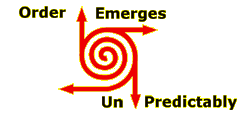



Natural and Human Systems Manifest as Inter-Active Networks
Constellating Their Interdependent Relationships Radically
Reconfigures Understanding of 'How Things Happen'
What is Constellation?
A style of thinking that reflects Nature’s interdependent interactivity—
allowing you to track unexpected connections, motives, and meanings
A style of thinking that reflects Nature’s interdependent interactivity—
allowing you to track unexpected connections, motives, and meanings
Constellation perceives the wholeness of what happens
In the most basic sense, to constellate is to perceive elements in groups or clusters of relationships. Thus a constellating perspective focuses not on single elements but the networks of relationships between various elements
In the most basic sense, to constellate is to perceive elements in groups or clusters of relationships. Thus a constellating perspective focuses not on single elements but the networks of relationships between various elements
Centered


and Distributed Networks


De-Centered


Constellation allows us to ‘see’ more than linear sequences
In everyday life we tend to rely upon sequential thinking and mechanical models to understand and describe events. This way of knowing is useful but necessarily incomplete. It severely reduces our awareness of interactive complexity. Realistic perception of ‘total contexts’ demands a more holistic perspective—one that ‘sees everything at once.’ The notion of constellation provides a way of describing such a perspective and the complex consciousness it can generate.
In everyday life we tend to rely upon sequential thinking and mechanical models to understand and describe events. This way of knowing is useful but necessarily incomplete. It severely reduces our awareness of interactive complexity. Realistic perception of ‘total contexts’ demands a more holistic perspective—one that ‘sees everything at once.’ The notion of constellation provides a way of describing such a perspective and the complex consciousness it can generate.
Sequencing Consciousness


versus


Constellating Consciousness


Constellation alters consciousness
Constellation’s focus upon the simultaneous interactions of multiple relationships challenges one’s ordinary sense of ‘how things happen.’ Since ordinary awareness ‘sees’ in terms of sequences, mechanical models, and simplistic judgments, the conscious practice of constellation can change the basic form of human consciousness. Through constellation we can engage an ‘extra-ordinary’ experience of our selves, others, and the world as contexts of concurrent interactivity having no distinct ‘beginning, middle, or end.’ Constellation brings us face to face with a strange version of reality where order and disorder prove to be interdependent.
Constellation’s focus upon the simultaneous interactions of multiple relationships challenges one’s ordinary sense of ‘how things happen.’ Since ordinary awareness ‘sees’ in terms of sequences, mechanical models, and simplistic judgments, the conscious practice of constellation can change the basic form of human consciousness. Through constellation we can engage an ‘extra-ordinary’ experience of our selves, others, and the world as contexts of concurrent interactivity having no distinct ‘beginning, middle, or end.’ Constellation brings us face to face with a strange version of reality where order and disorder prove to be interdependent.
Constellation exposes relationships that are ordinarily ‘invisible’
Constellating dynamic relationships exposes unexpected feedback loops that influence our relationships. It shows how seeking security and control can cause chaos. It confronts us with the essential roles of confusion, contradiction, and conflict in life—the ‘disorder of order.’ It is most always surprising and sometimes shocking—
Constellating dynamic relationships exposes unexpected feedback loops that influence our relationships. It shows how seeking security and control can cause chaos. It confronts us with the essential roles of confusion, contradiction, and conflict in life—the ‘disorder of order.’ It is most always surprising and sometimes shocking—
Because constellating:
> Mirrors the dynamic totality of events, relationships, and concepts obscured by ordinary reduction
> Expands and interrelates psycho-logical, socio-logical, eco-logical, and mytho-logical understandings
> Articulates self and world as unpredictably interactive, self-organizing networks
> Evades the biases of reductive thought, competitive argument, idealism, and simplistic judgments
“Dynamic Constellation:” an interdisciplinary set of constellating practices
Constellating perspectives are found across a diverse range of analytical and imaginative methods for representing complexity. The ‘techno-logical’ thought of reductive science, the rational analysis of philosophy and psychology, and the ‘symbol-logical’ representations of art and myth all manifest constellating perspectives. Facts as well as symbols, theories as well as stories, aid in tracking interdependent interactivity These methods are brought together under the interdisciplinary concept of Dynamic Constellation. This term is meant to identify an approach to contexts, relationships, concepts, and structures as actively evolving networks—or ‘dynamic constellations.’ In practice, Dynamic Constellation is meant to produce tangible understanding of reality’s profound interactivity.
Constellating perspectives are found across a diverse range of analytical and imaginative methods for representing complexity. The ‘techno-logical’ thought of reductive science, the rational analysis of philosophy and psychology, and the ‘symbol-logical’ representations of art and myth all manifest constellating perspectives. Facts as well as symbols, theories as well as stories, aid in tracking interdependent interactivity These methods are brought together under the interdisciplinary concept of Dynamic Constellation. This term is meant to identify an approach to contexts, relationships, concepts, and structures as actively evolving networks—or ‘dynamic constellations.’ In practice, Dynamic Constellation is meant to produce tangible understanding of reality’s profound interactivity.
For further detail on constellation see the More Info Page
Think More Realistically—Constellate Your Consciousness
Browse the site or contact me now to discuss how these concepts apply to you
© Leslie Emery 2010. All Rights Reserved
Two ways of ‘seeing’:
Seeing Separate Parts & Actions


Versus
Seeing Sets of Relationships


Constellation reveals the ‘de-centered’ structure of natural networks
Constellating perspective enables us to perceive the essential differences between how connections in centerless or ‘distributed networks’ create fully interactive sets of relationships that do not have a hierarchical structure.
Constellating perspective enables us to perceive the essential differences between how connections in centerless or ‘distributed networks’ create fully interactive sets of relationships that do not have a hierarchical structure.